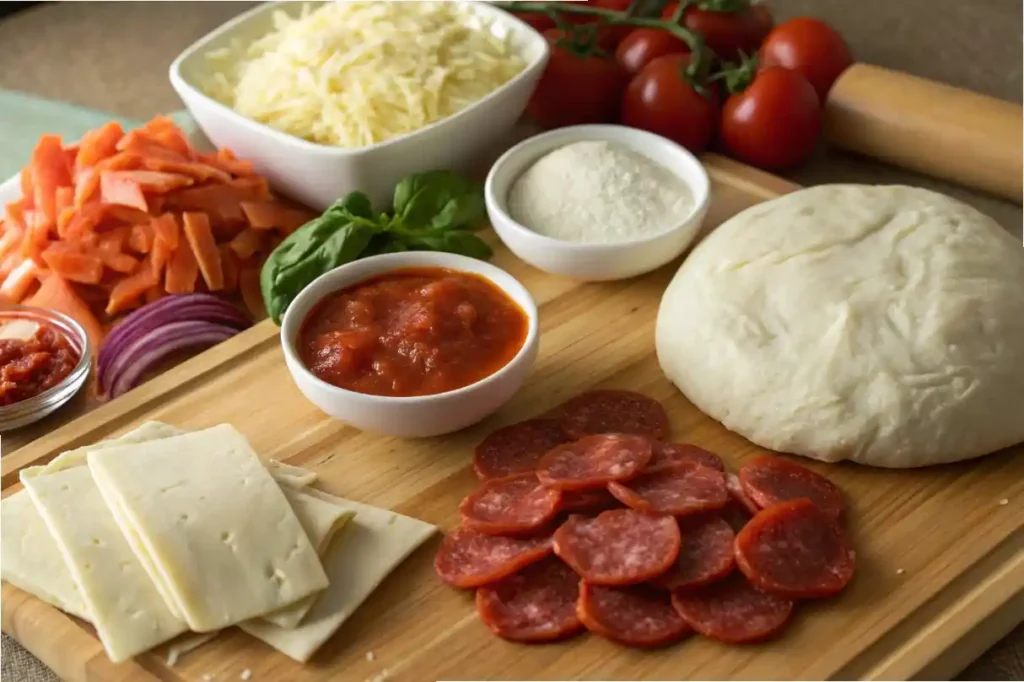Pizza puffs are a popular snack loved for their crispy exterior and cheesy, savory filling. However, their nutritional value often raises questions. In this article, we’ll explore what goes into pizza puffs, their calorie and nutrient content, and whether they can fit into a healthy diet. Plus, we’ll share tips for making healthier versions at home!
Table of Contents
1. What Are Pizza Puffs?
Origins and Popularity of Pizza Puffs
Pizza puffs originated in Chicago and quickly became a beloved street food. Known for their flaky crust and gooey filling, they’re a convenient snack that combines the flavors of pizza in a portable form. Over time, pizza puffs have gained popularity across the U.S., appearing in fast-food menus and grocery stores. Their versatility and indulgent taste make them a go-to comfort food for many.
What Goes Into a Pizza Puff?
A typical pizza puff consists of a doughy crust filled with ingredients like mozzarella cheese, tomato sauce, and various toppings such as pepperoni or vegetables. The dough is often made with refined flour, and the filling can include processed meats and high-fat cheeses. These ingredients contribute to the rich flavor but also add calories, fat, and sodium, making them a less-than-healthy choice.
How Are Pizza Puffs Made?
Pizza puffs are usually deep-fried, giving them their signature crispy texture. However, some versions are baked for a lighter alternative. The cooking method significantly impacts their nutritional profile, as frying adds extra fat and calories. Regardless of how they’re prepared, pizza puffs are designed to be indulgent, making them a treat rather than an everyday meal.

2. Nutritional Breakdown of Pizza Puffs
Calories and Macronutrients
Pizza puffs are calorie-dense, with an average serving (170g) containing around 400 calories. These calories primarily come from fats and carbohydrates, with a smaller contribution from protein. The dough and cheese are the main culprits for the high carb and fat content. While they provide energy, consuming pizza puffs frequently can lead to excessive calorie intake, which may contribute to weight gain.
Sodium and Cholesterol Levels
One of the biggest concerns with pizza puffs is their high sodium content. A single serving can contain over 800mg of sodium, which is nearly 35% of the recommended daily intake. Excessive sodium can lead to high blood pressure and other cardiovascular issues. Additionally, the use of processed meats and cheese increases cholesterol levels, which may negatively impact heart health if consumed in large quantities.
Micronutrients and Additives
While pizza puffs may contain small amounts of vitamins and minerals like calcium (from cheese) and iron (from enriched flour), these benefits are often overshadowed by the presence of artificial additives and preservatives. Store-bought versions frequently include stabilizers and flavor enhancers, which can be harmful in large amounts. Homemade versions, however, can avoid these additives and offer a slightly healthier option.
3. Are Pizza Puffs Healthy or Unhealthy?
The Case for Pizza Puffs Being Unhealthy
Pizza puffs are undeniably indulgent, but their high fat, calorie, and sodium content makes them a less-than-ideal choice for regular consumption. The deep-frying process adds unhealthy trans fats, while the processed ingredients contribute to poor nutritional value. Over time, frequent consumption of such snacks can lead to health issues like obesity, high blood pressure, and heart disease.
Can Pizza Puffs Be Made Healthier?
Yes, pizza puffs can be made healthier with a few tweaks. For instance, using whole-grain dough instead of refined flour can increase fiber content. Opting for low-fat cheese and fresh vegetables as fillings can reduce fat and calorie levels. Additionally, baking instead of frying significantly cuts down on unhealthy fats, making them a more balanced snack option.
Comparing Pizza Puffs to Other Snacks
When compared to other popular snacks like chips or burgers, pizza puffs fall somewhere in the middle. While they may have more protein than chips, they’re often higher in fat and sodium. Burgers, on the other hand, can be customized with leaner meats and whole-grain buns, making them potentially healthier. Ultimately, pizza puffs are best enjoyed occasionally as a treat rather than a staple snack.

4. Healthier Alternatives to Pizza Puffs
Homemade Pizza Puffs
Making pizza puffs at home allows you to control the ingredients and preparation methods. Start with whole-grain dough to boost fiber content and use low-fat cheese to reduce saturated fat. Fillings like fresh vegetables, lean meats, or plant-based proteins can add nutrients without extra calories. Baking instead of frying is another great way to cut down on unhealthy fats while still achieving a crispy texture.
Store-Bought Healthier Options
If you prefer convenience, some brands offer healthier versions of pizza puffs. Look for options labeled as baked rather than fried, and check the ingredient list for whole grains and natural fillings. Additionally, pay attention to sodium levels and avoid products with excessive preservatives or artificial additives. Reading nutrition labels carefully can help you make smarter choices when buying pre-made pizza puffs.
Other Snack Alternatives
If you’re craving something similar but healthier, consider snacks like baked samosas, veggie wraps, or whole-grain quesadillas. These options provide similar flavors and textures but often come with fewer calories and more nutrients. For example, veggie wraps can be packed with fresh produce and lean proteins, making them a satisfying and nutritious alternative to pizza puffs.
5. The Role of Moderation
How Often Should You Eat Pizza Puffs?
Pizza puffs are best enjoyed as an occasional treat rather than a regular part of your diet. Consuming them too often can lead to excessive calorie and sodium intake, which may contribute to health issues over time. However, indulging in moderation—perhaps once or twice a month—can help you satisfy cravings without derailing your overall health goals. Pairing them with a side of fresh salad can also balance the meal.
Balancing Pizza Puffs with Exercise
If you love pizza puffs but worry about their impact on your health, incorporating regular exercise into your routine can help. Physical activity burns calories and supports cardiovascular health, which can offset the occasional indulgence. Moreover, maintaining a balanced diet with plenty of fruits, vegetables, and lean proteins ensures that treats like pizza puffs don’t dominate your nutritional intake.
6. FAQs About Pizza Puffs
1. Are Puff Patties Healthy?
Puff patties, like pizza puffs, are often made with refined flour and high-fat fillings, making them calorie-dense and low in nutrients. While they may be slightly different in flavor or shape, the nutritional concerns remain similar. However, homemade versions with whole-grain dough and healthier fillings can be a better option. Ultimately, puff patties, like pizza puffs, are best enjoyed in moderation as an occasional treat.
2. Why Are Pizza Puffs So Good?
Pizza puffs are loved for their crispy exterior and gooey, flavorful filling. The combination of melted cheese, savory toppings, and flaky dough creates a comforting and indulgent snack. Moreover, their portability and convenience make them a popular choice for on-the-go meals. However, their appeal often comes at the cost of high fat, sodium, and calorie content, which is why they should be eaten sparingly.
3. Are Egg Puffs Good or Bad for You?
Egg puffs, like pizza puffs, can be both good and bad depending on how they’re made. They often contain eggs, spices, and a flaky crust, which provides protein but also adds fat and calories. Store-bought versions may include preservatives and high sodium levels, making them less healthy. Opting for homemade egg puffs with whole-grain dough and minimal oil can make them a more balanced snack.
4. Can I Eat Puffs During Weight Loss?
Yes, you can enjoy puffs during weight loss, but portion control is key. Since pizza puffs and similar snacks are high in calories and fat, they should be treated as an occasional indulgence rather than a regular meal. Pairing them with a side of fresh vegetables or a light salad can help balance the meal. Additionally, tracking your calorie intake ensures they fit within your daily goals.
7. Conclusion
Pizza puffs are a delicious and indulgent snack, but their high calorie, fat, and sodium content makes them a less-than-ideal choice for regular consumption. While they can be enjoyed occasionally, healthier alternatives like homemade versions or baked options are worth considering. Moderation is key, and balancing treats like pizza puffs with a nutritious diet and regular exercise can help you maintain a healthy lifestyle.
For those looking to explore healthier recipes, check out healthy enchiladas or healthy sides for burgers for inspiration. These options provide flavorful alternatives that align with a balanced diet.
To learn more about the origins and variations of pizza puffs, visit the Wikipedia page on pizza puffs. This resource offers a deeper dive into their history and cultural significance.
Ultimately, pizza puffs can be part of a balanced lifestyle when enjoyed in moderation. By making smarter choices and exploring healthier alternatives, you can satisfy your cravings without compromising your health goals.

